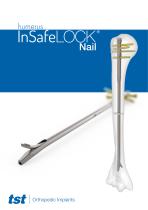
Humeral intramedullary nail InSafeLOCK proximal fixationrightleft

Add to favorites
Compare this product
fo_shop_gate_exact_title
Characteristics
- Joint / bone
- humerus
- Fixation
- proximal fixation
- Side
- right, left
- Materials
- titanium
- Length
Min.: 180 mm
(7.1 in)Max.: 300 mm
(11.8 in)- Proximal diameter
9 mm
(0.4 in)- Degree of curvature
5 °
Description
InSafeLOCK Humerus Nail is an innovative intramedullary nail system developed for ease of application. While it enables locking with the help of an internally safe locking pin (Endopin) in the distal, it provides multiple proximal locking and compression in different planes with the static transverse, static angled, dynamic compression locking holes, and screw application options through the calcar angled hole in the proximal.
6 mm compression over the dynamic hole in the proximal part
4 mm diameter Ti6Al7Nb endopin that attaches to the posterior cortex
Properties
InSafeLOCK Humerus Nail is cannulated and round in diameter.
The same nail is used in the right and left applications.
There is no need for fluoroscopy for distal and proximal locking.
It is adapted for reamed and unreamed applications.
It has a 3 cm long, 5° anterior angled distal part design to easily advance the nail to the distal edge and increase the rotational stability efficiency.
The nail can be placed to its most distal edge (proximal edge of the olecranon fossa).
It provides an aesthetic advantage for there is no distal skin incision.
Because of the distal lock with protruding design from interior to posterior;
Provides functional advantage by not causing damage to muscle, tendon, fascia,
Does not cause nerve injury in radial, median and musculocutaneous,
Screw loosening, migration, and irritation do not occur in the distal lock,
Because of the shortening of the application time and the ease of application, it makes saves the operation time.
VIDEO
Catalogs
humerus InSafeLOCK Nail
28 Pages
Related Searches
- Bone plate
- Compression plate
- Metallic compression plate
- Locking compression plate
- Titanium compression plate
- Distal compression plate
- Arthrodesis nail
- Lateral compression plate
- Humeral compression plate
- Metallic intramedullary nail
- Femoral stem
- External fixation system
- Adult external fixation system
- Proximal fixation intramedullary nail
- Acetabular prosthesis
- Titanium intramedullary nail
- Cementless femoral stem
- Press-fit acetabular prosthesis
- Right intramedullary nail
- Left intramedullary nail
*Prices are pre-tax. They exclude delivery charges and customs duties and do not include additional charges for installation or activation options. Prices are indicative only and may vary by country, with changes to the cost of raw materials and exchange rates.


